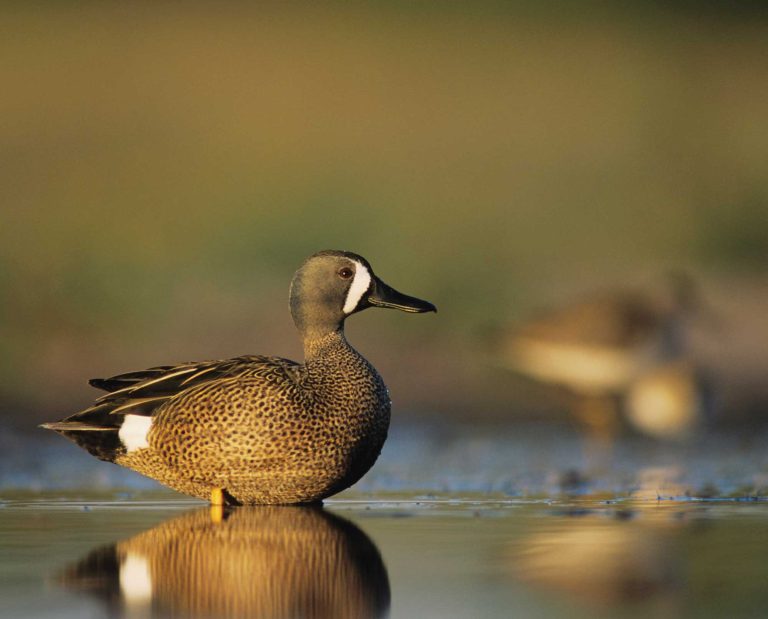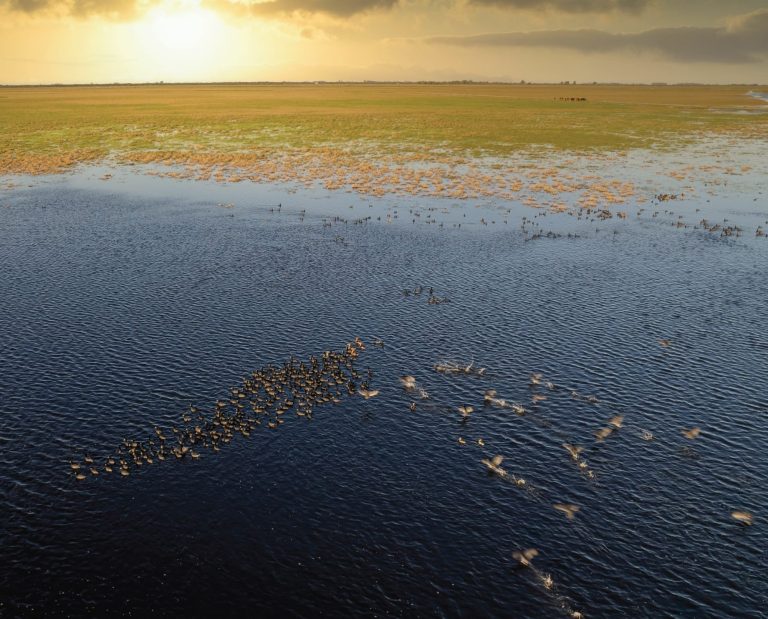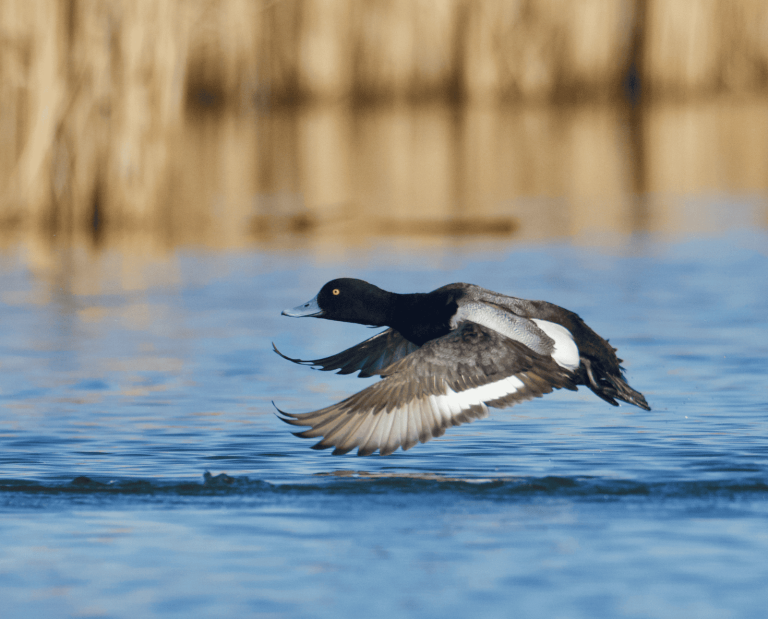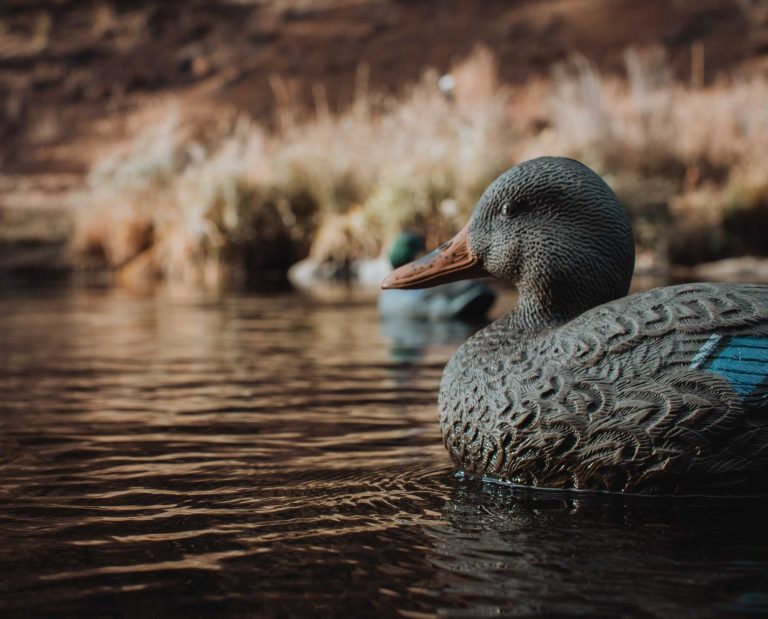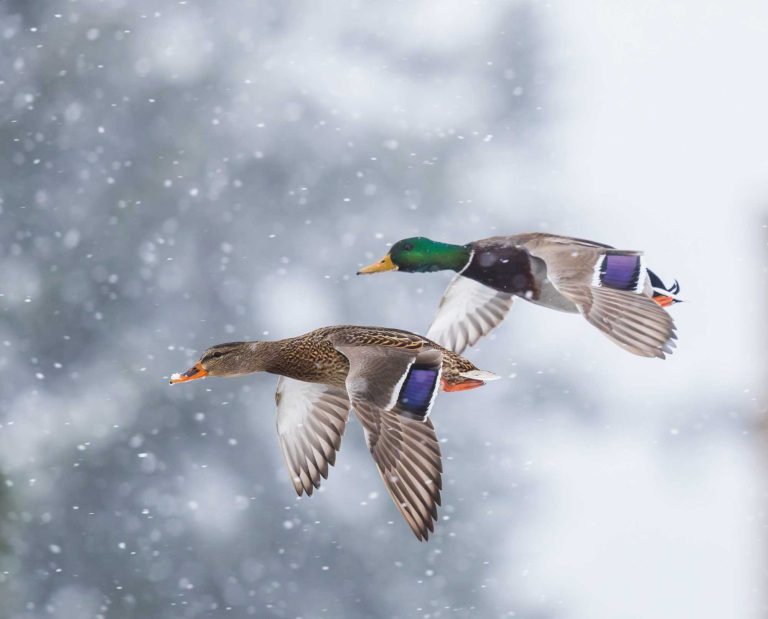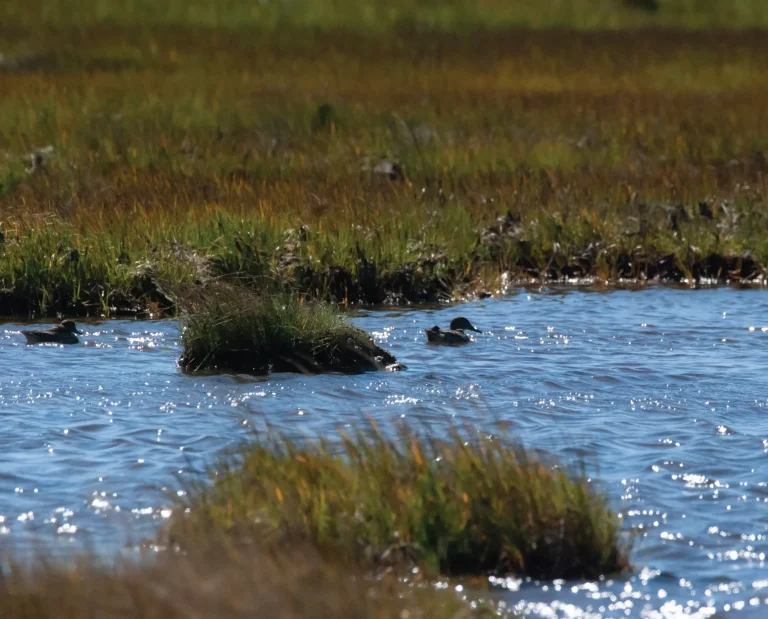Common Goldeneye (Bucephala clangula) – Waterfowl Species Profile
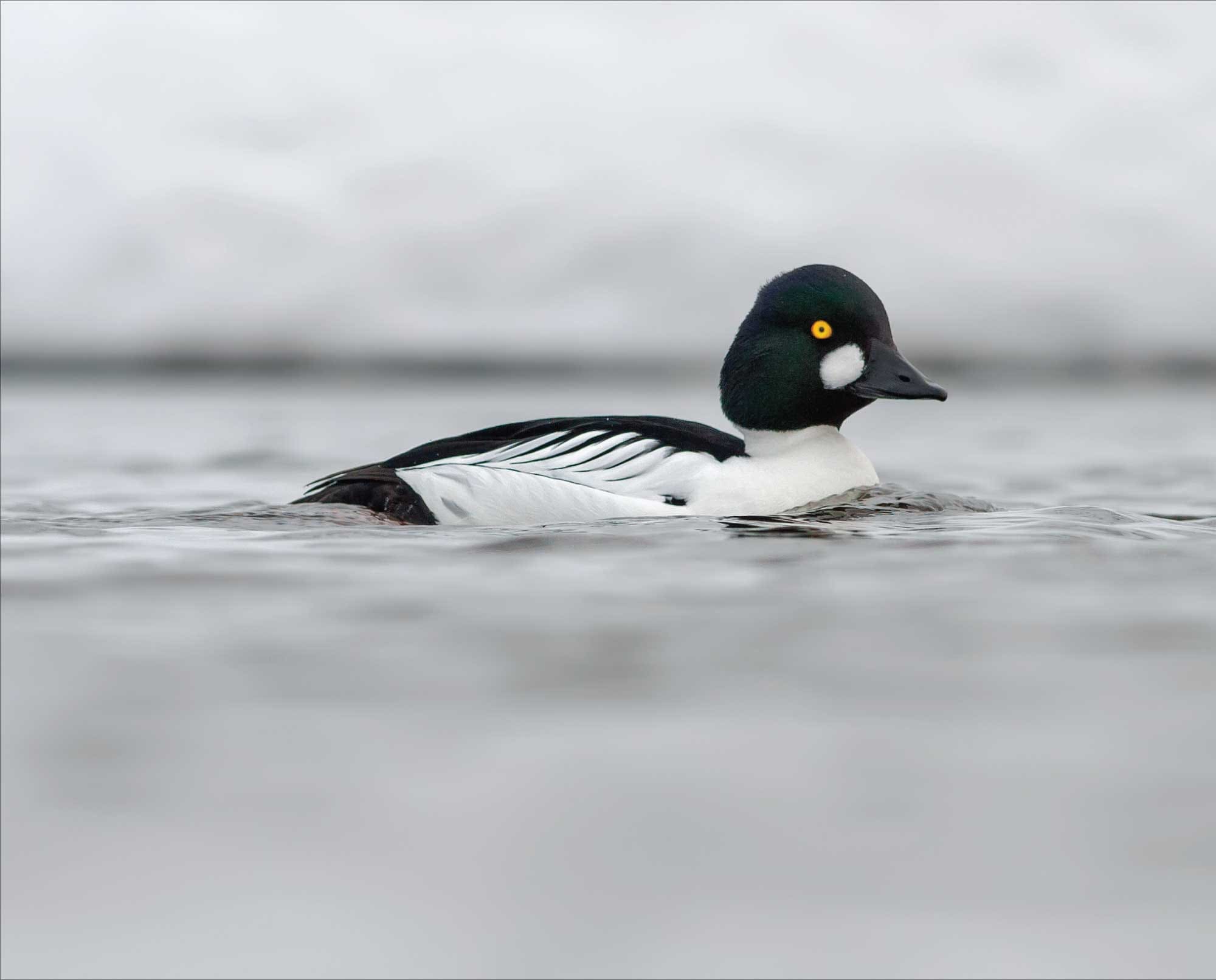
Discover the beautiful duck with whistling wings
The common goldeneye (Bucephala clangula) is a medium-sized duck that is true to its name as well as its nickname. The drake’s brilliant yellow eyes stand out from its iridescent, dark green head. Often called “whistlers”, their wings make a very loud whistling sound that can help identify them from the duck blind. They are also a late migrant, often making their way south from Canada right during ice-up.
Description and life history of the goldeneye
The common goldeneye is a moderately small duck that measures about 16 to 18 inches long and weighs about 2 pounds (NatureServe 2020). Breeding drakes stand out with their bold white body and breast, black tail and back, and iridescent greenish black head. Their relatively large heads have a sloping black bill and a bright white circle right behind the bill. Females, however, have a gray-colored body with medium brown-colored heads, a creamy white collar on their necks, and mostly black bills with a yellow tip. Adults of both genders have yellow irises (hens are paler yellow than drakes), though their eye color changes several times from the moment they are hatched (All About Birds 2020). In flight, their blackish gray wings have a white speculum only on the inner half. Their close cousin, the Barrow’s goldeneye, can be distinguished from a common goldeneye by to the drake’s iridescent purple head and white crescent shape behind the bill. The hens look very similar.
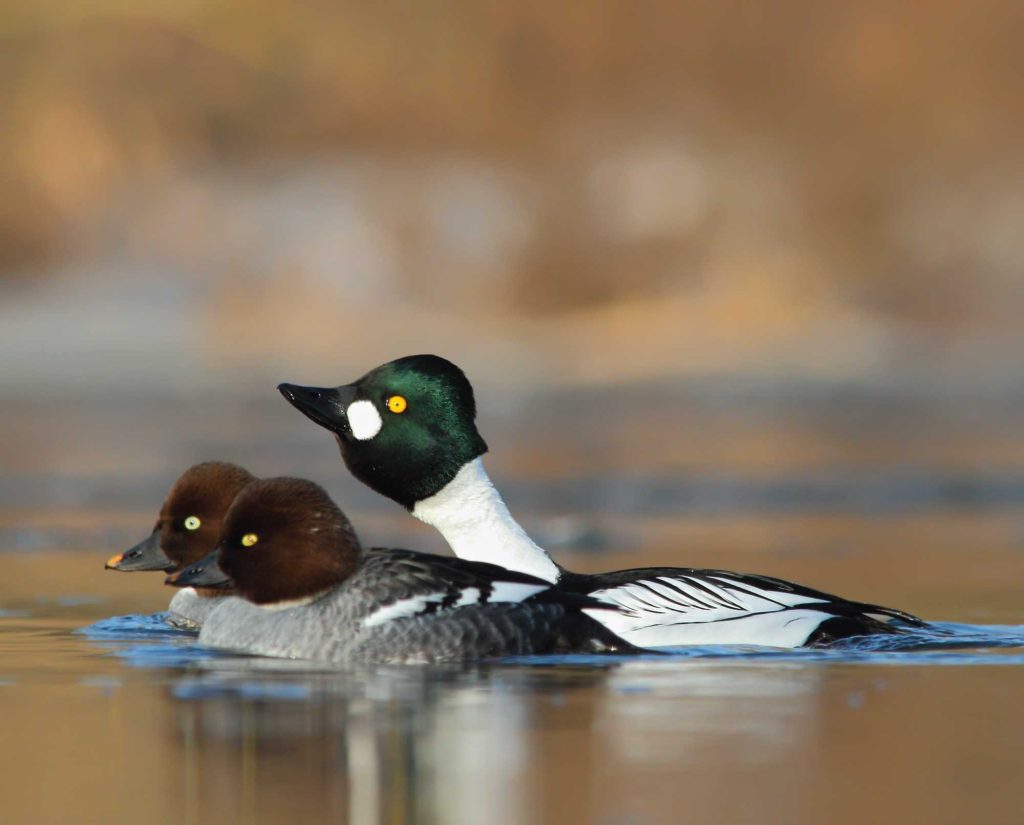
In late winter, pairs begin to form with males performing a curious courtship ritual. Like redheads, goldeneye drakes bend their heads backward to touch their tails, and then pop them forward again while making a loud call (All About Birds 2020). Hens often look for future nest locations at the end of the breeding season but may return to the same area year after year. Generally, nests are located in a natural tree cavity of large deciduous trees (including abandoned woodpecker holes), but they also readily nest in nest boxes, much like wood ducks (NatureServe 2020). Nests are typically located close to a water source, such as a pond, lake, or river (All About Birds 2020). The female lines the nest cavity with wood chips, old squirrel nest materials, and downy feathers. A hen will lay 8 to 12 olive or blue-green eggs and incubate them for 28 to 32 days (National Audubon Society 2020; NatureServe 2020). Since nest sites in tree cavities may be up to 60 feet above the ground, the ducklings need to leap to the ground shortly after hatching (National Audubon Society 2020).
The common goldeneye is a diving duck and primarily an insectivore, although plant materials are on the menu too. Crustaceans (e.g., crabs, shrimp, crayfish), mollusks (e.g., mussels, barnacles, snails), aquatic insects (e.g., caddisfly larvae, mayflies, damselflies, beetles), leeches, frogs, and fish/fish eggs (e.g., minnows, sculpin, young salmon) are all a critical part of their diet (All About Birds 2020; National Audubon Society 2020). However, they also consume seeds, tubers/roots, and leaves of pondweeds and bulrush during the breeding season.
Because hens primarily nest in tree cavities, they can be susceptible to predation while nesting. Some known predators of hens, ducklings, and eggs include black bears, marten, mink, raccoons, raptors, red squirrels, and northern pike (BioKIDS 2020).
Range and habitat of the goldeneye
The common goldeneye’s range in North America lies throughout Canada, Alaska, and the lower 48 states. They generally migrate north to breeding areas across Canada and Alaska by February and March. In November they return to wintering areas, which primarily includes the Pacific and Atlantic coastal states, large water bodies in the Intermountain West and Pacific Northwest, and the Great Lakes (NatureServe 2020). Less commonly, they may also overwinter throughout the rest of the U.S.
During the breeding season, goldeneyes mostly utilize boreal woodlands adjacent to waterbodies, such as lakes, rivers, bogs, marshes, or other small wetlands (All About Birds 2020). Migrating individuals will stop at larger lakes and rivers along their course. In the winter months, they prefer coastal areas, protected bays, and estuaries that support healthy crustacean and mollusk populations (All About Birds 2020). However, they may also use large lakes and rivers in interior states provided they stay ice-free and have adequate food sources (National Audubon Society 2020).
Conservation issues for the goldeneye
The common goldeneye is a fairly common bird and is listed as globally secure and of Least Concern by the IUCN Red List (NatureServe 2020). While the breeding population is tough to estimate due to their remote woodland breeding habitats, it’s believed that populations were stable or even increased from 1966 to 2014 (All About Birds 2020). In breeding areas, forestry practices that retain dead snag trees should be encouraged to provide additional nest sites. Alternatively, the use of nest boxes throughout their breeding range can help as well. Threats to their wintering habitats include loss of wetlands, channelization of river systems, and increased sediment loads that can affect foraging areas and reduce mollusk populations (All About Birds 2020). Hunters harvest between 85,000 and 90,000 birds annually, which includes common and Barrow’s (All About Birds 2020).
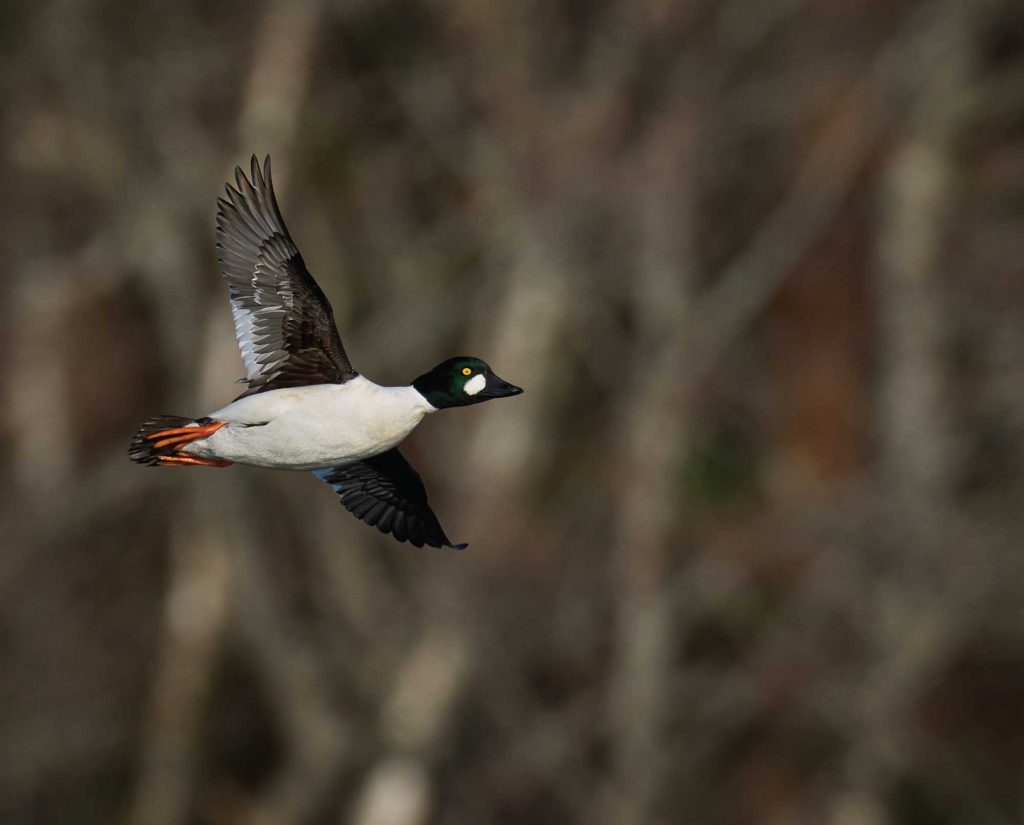
Hunting opportunities for the goldeneye
Because the common goldeneye is such a late migrator, a late season hunt is probably your only chance of encountering one. In fact, you should expect to be most successful when the water bodies just north of you are starting to freeze over. The New England states in the Atlantic flyway, the Pacific Northwest states in the Pacific flyway, and the Great Lakes states in the Mississippi flyway offer the best opportunities for goldeneyes according to previous harvest statistics.
Equipment and Bag Limits
In addition to your common duck hunting gear – hunting license/federal duck stamp, shotgun, non-toxic shells, a blind or boat, and decoys – you should make sure to bring multiple layers of warm clothing for those cold late season conditions. Bringing a thermos of coffee or hot soup always makes things more enjoyable in the duck blind too. If you plan to hunt river systems, having a quality retriever with you will make your life much easier. Some states consider goldeneyes to be sea ducks, while others exclude them from that classification in their hunting regulations. Common goldeneyes are not specifically addressed in many state regulations, and so the current daily bag limit is six birds. Washington, however, has a daily bag limit of 2 goldeneyes in one of their zones. Always check your specific state and location for the current limit.
Goldeneye Hunting Techniques
Goldeneyes can be antisocial and even aggressive to other species of waterfowl. So while you can certainly still attract them with a mixed spread of various diver decoys, keep a half dozen goldeneye dekes (hens and drakes) off by themselves a bit, within shooting distance of course. Also, it’s more likely that small flocks or even singles will come through – it’s not like hunting huge flocks of bluebills. As a result, you don’t need huge numbers of goldeneye-specific decoys either. Because of their nickname (“whistlers”), you will probably hear them approaching before you see them. As always, get ready if you hear the sound of whistling wings. And despite their size, goldeneyes are tough ducks that can survive in harsh, cold conditions. This can make them tough to kill and their diving skills can help them elude hunters. To reduce your crippling rate, make sure they are finished by the time they hit the water. Otherwise, best of luck if you get out after some whistlers!



